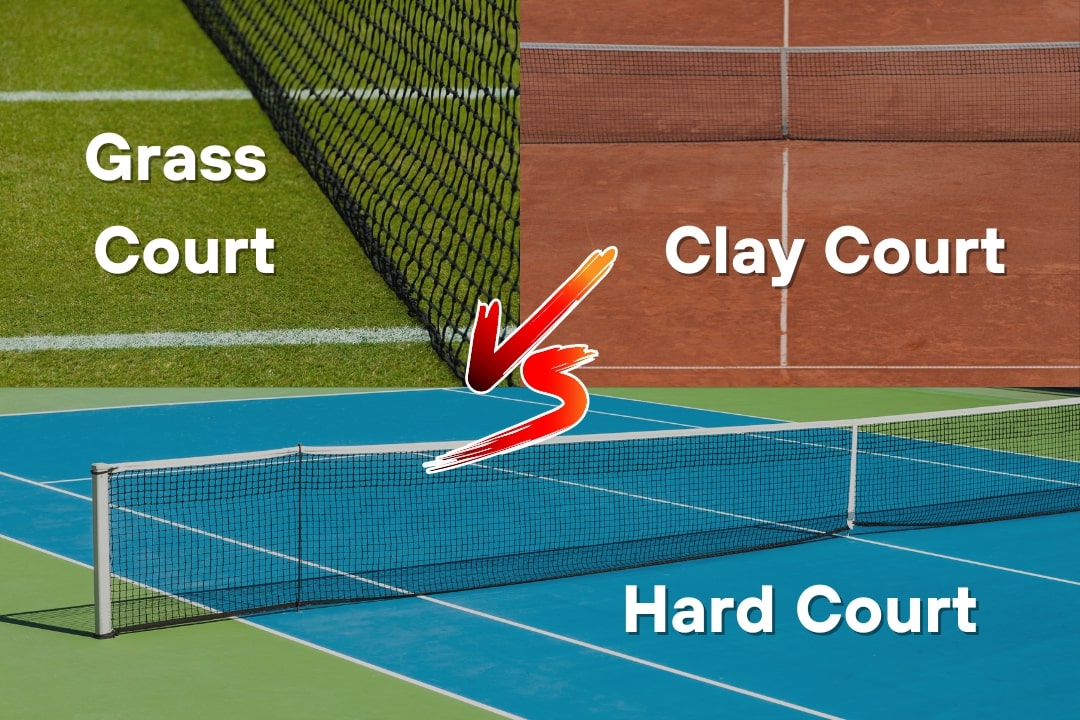If you are a tennis fan, you may know Rafael Nadal as the “King of Clay Courts”. Roger Federer, on the other hand, is popular for his dominance in grass courts. Why was Pete Sampras able to win all Grand Slam Championships but has never won one played on a clay surface? This is because the type of court surface significantly influences how we play tennis.
So, what are the different types of tennis court surfaces?
The different types of tennis court surfaces are grass, hard (acrylic, asphalt, concrete), clay, green clay, hybrid clay, artificial clay, artificial grass, carpets, and others (wood, tile, canvas). The three court surfaces that are used in professional tournaments are grass, hard, and clay.
Here is a table that shows the comparison between three main types of court surfaces (clay, grass, hard) in tennis:
| Court Surface | Characteristics | Best For |
| Clay | Slow, high bounce | Baseline players with topspin shots, long rallies |
| Grass | Fast, low bounce | Serve and volley, powerful flat shots |
| Hard | Medium speed, medium bounce | All-around player |
This articles will discusses the 12 courts in more detail, including the usage of each court surfaces used for and their pros and cons. Here are 12 different types of tennis court surfaces:
Table of Contents
1. Grass Courts
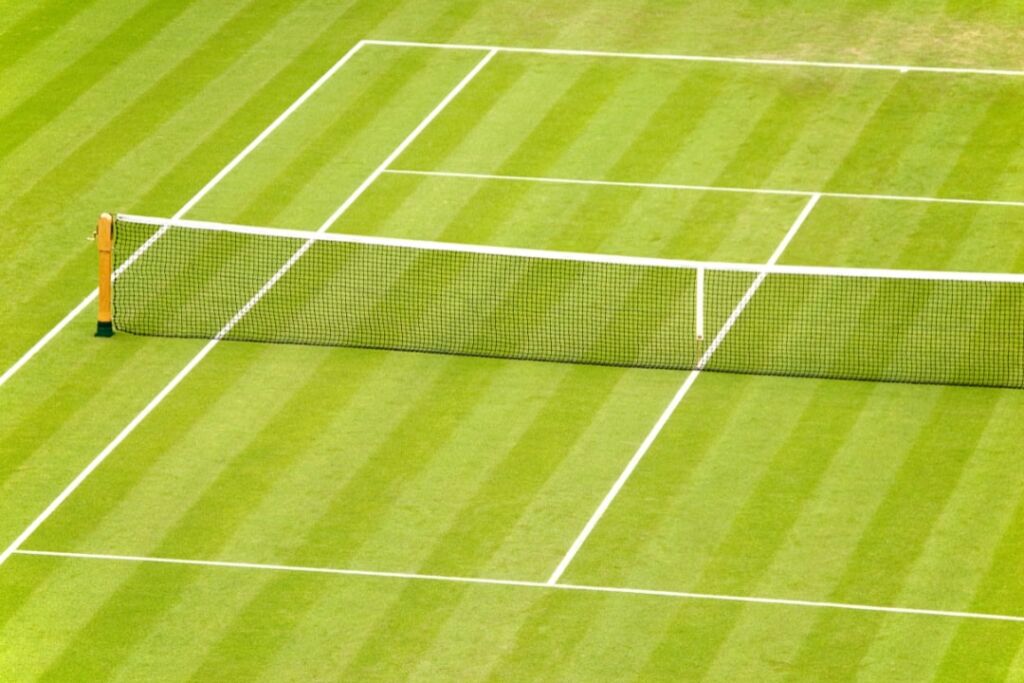
Grass is the surface that modern tennis was first played on during the 18th century. It was originally called Lawn Tennis, as they are played on grass (lawn) courts.
Grass court is known for being the fastest court. Meaning that the ball travels fastest after making contact with the grass surface. In addition, balls bounce much lower due to the soil being softer than other court materials.
The lower and faster bounce of balls makes it more challenging for players to return the ball. This is why grass courts produce the most serve aces and the fastest rally length. A tennis match on a grass court tends to end much earlier on average.
Grass court favors good servers and baseliners who hit the ball flat or with a lot of power.
A good strategy to win matches on grass courts is to utilize “serve and volley”. The ball coming in from a big, powerful serve will travel very fast on grass courts, increasing your chance to get serve aces. This playstyle favors taller players.
Use powerful flat balls instead of spin shots. Flat balls travel fast in the grass, resulting in a fast winner shot.
Due to the ball’s lower bounce, you should never forget to bend your knees to consistently hit the ball lower.
In the professional scene, grass courts are only seen in Wimbledon Championships.
Wimbledon was the first professional tennis tournament in the world. It was first held in 1877 when tennis was mostly played on grass (lawn tennis).
Maybe it is due to tradition, but Wimbledon tournaments are still played on grass courts until today.
Today, grass courts are rarely seen outside of the Wimbledon Championship. If you are just playing casually or for recreational purposes, you will be lucky to experience playing in a traditional grass tennis court.
Grass courts are declining in popularity because they are costly to build and hard to maintain.
Since the materials used are natural grass, maintenance such as regular watering, mowing, and fertilizing need to be constantly done to keep the court playable, which can be time-consuming and costly.
The court is also more slippery, especially when it is wet. The court became unplayable when it got hit even by light rain drizzles.
One example of a professional player who is great at grass courts is Roger Federer, who has won 20 grand slam titles, with 8 of them at Wimbledon.
2. Hard Courts (Acrylic)
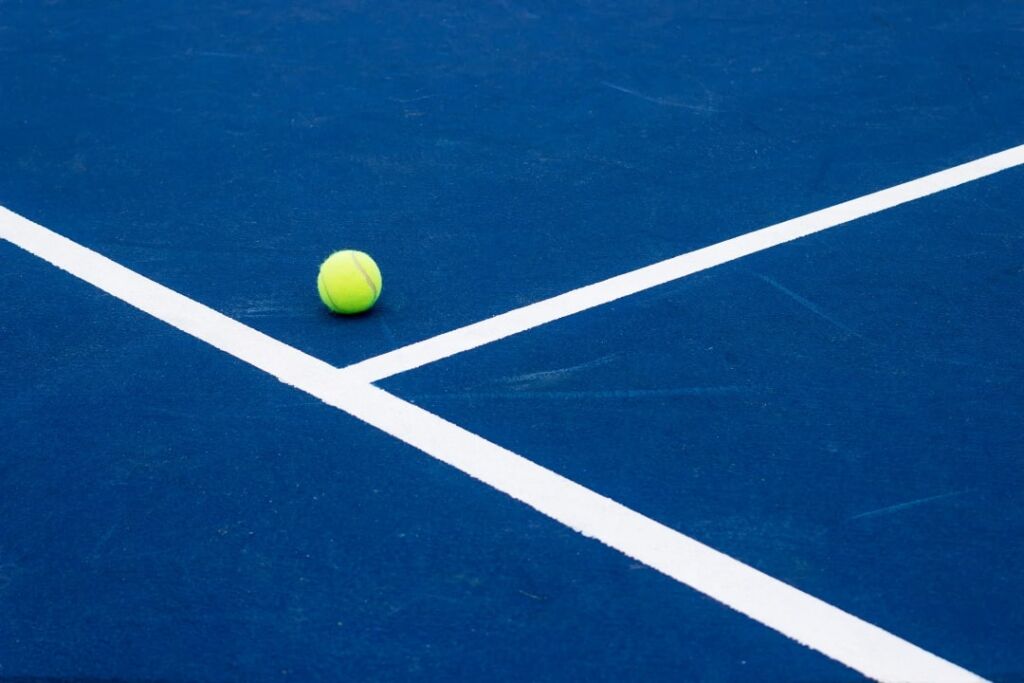
The base materials used to make hard courts are asphalt or concrete. Most hard courts are improved further by coating with acrylic surface layers to provide cushioning. They are often painted in blue or green.
The hard courts are the most common court surface in tennis as it is the easiest to maintain.
They are easy to build, require very low maintenance, and dry off quickly if wet, making it a suitable court even in rainy weather.
Out of all the other court surfaces, hard courts are the most balanced and all-around court.
They are a middle ground between grass and clay courts, where the ball travels at a medium speed (slower than on grass but faster than on clay courts).
The ball’s bounce varies depending on the type of hard court. Some hard courts have a very high bounce, and others have a lower bounce where the ball skids more.
Due to the flat surface, the ball bounces predictably, leading to a balanced offense and defense.
A balanced playstyle between baseline shots and net plays is often played. Both flat and spin shots are equally effective in hard courts.
Hard courts coated with acrylic layers are the most popular hard courts used by most professional tournaments. Some notable major professional tours using acrylic hard courts include the US Open, Australian Open, ATP/WTA World Tour Finals, and Shanghai Masters.
3. Hard Courts (Asphalt)
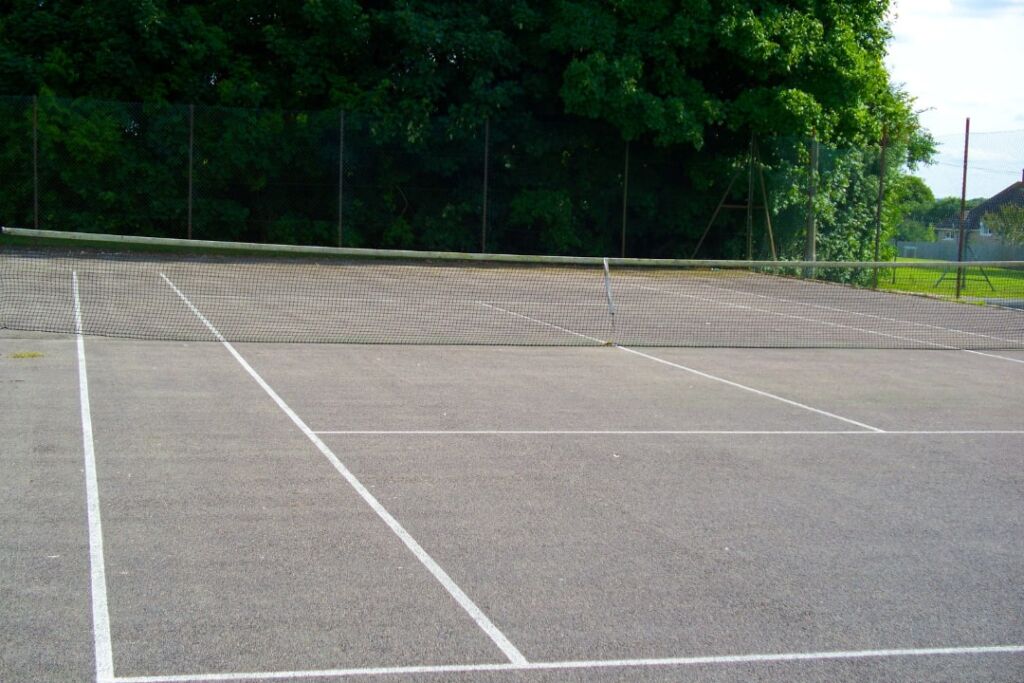
Asphalt courts are built the same way as acrylic courts but without the coating. So they are more prone to cracks and damage over time.
Because of this, asphalt courts require more frequent maintenance and can be costly in the long run. The acrylic hard courts are superior to asphalt courts in every way, which is why asphalt courts are not used in professional tournaments.
4. Hard Courts (Concrete)
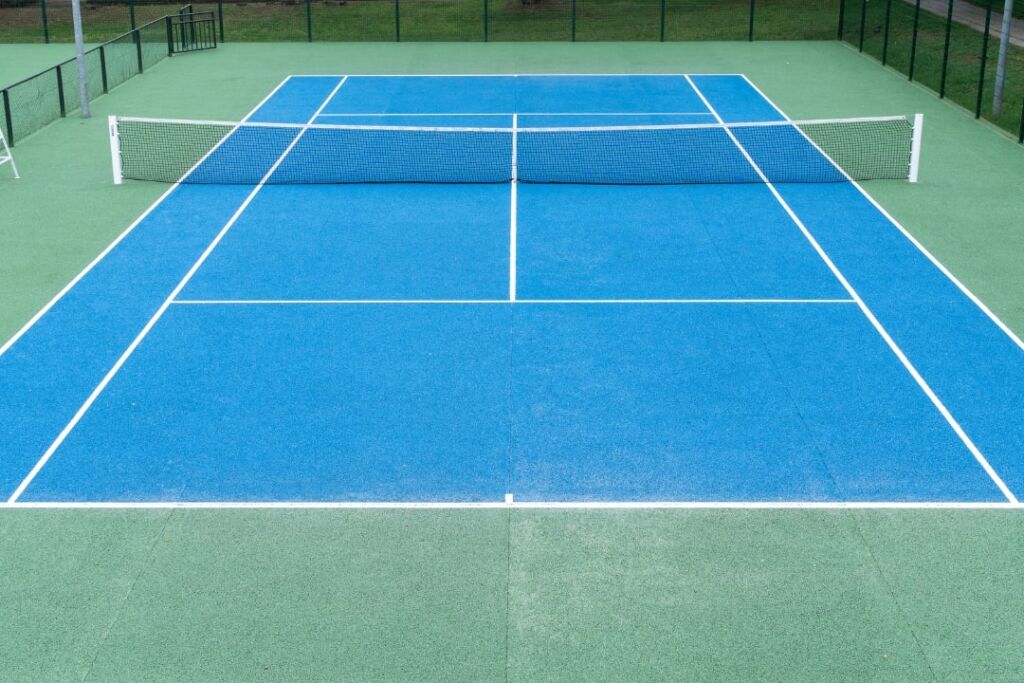
Concrete courts are generally more durable and easier to maintain than asphalt courts. They are made of concrete, materials that provide good traction and ball control.
However, concrete courts are not used in professional tournaments, as the acrylic courts are superior.
The disadvantage of hard courts is that they easily injure players, especially if they fall.
Due to the harder surface compared to other courts, the player’s weight generates more impact on the player’s knee joints when moving.
One example of a professional player who is great at hard courts is Novak Djokovic, who has won 18 grand slam titles, with 12 of them on hard courts.
5. Clay Courts
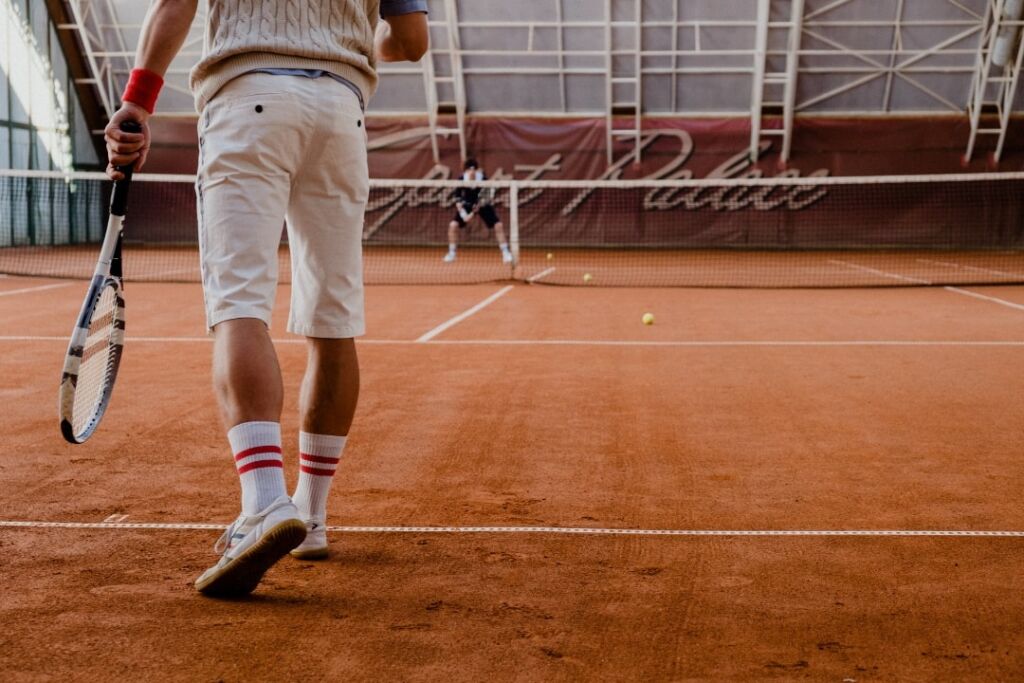
There are two forms of clay tennis courts: red clay court and green clay court (Har-Tru). The red clay courts are the standard ones you usually see everywhere.
Red clay courts are very popular in Europe and South America. The surface of clay courts is not actually clay but a combination of crushed stone, brick, or shale with a red color.
The clay courts are commonly played at the French Open tournament at Roland Garros.
Clay courts are the slowest court surface, as the ball bounces slower and higher after contact. Hitting a winner on clay courts is difficult, leading to longer rallies and overall match length.
Clay courts are favored mainly by baseline players who like defending and generating heavy spins on their shots.
Flat shots are less effective as the ball loses speed when it contacts the surface. The most effective ones are spin spots such as topspins and kick serves, as the ball bounces higher in clay courts.
Playing on clay courts also needs some getting used to, as you need to be able to master sliding.
In clay courts, you will feel slower and harder to change direction. Thus, sliding is used to be quicker and reduce the risk of injuries.
You will also need plenty of stamina to excel on clay, as rallies will last longer.
Because of the nature of the clay material, the court will require heavy maintenance.
Water needs to be poured regularly, which can be costly and time-consuming. If not, the dry court will feel like you are playing on the sand. It can’t be too wet, since it will be slippery and unsuable.
Other than water pouring, regular rolling will also be needed. In clay courts, the court surface tends to be uneven and causes the balls to bounce unpredictably.
One example of a professional player who is great at hard courts is Rafael Nadal, who has won 20 grand slam titles, with 13 of them in the French Open.
6. Green Clay Courts (Har-Tru)
Green clay court (Har-Tru) is made of crushed metabasalt. Har-tru is more slippery than red clay and harder to change directions when moving.
Compared to red clay courts, the ball travels quicker after contact but is still slower than grass and hard courts. Like red clay courts, the ball bounces higher, making topspins an effective shot to use.
7. Hybrid Clay Courts
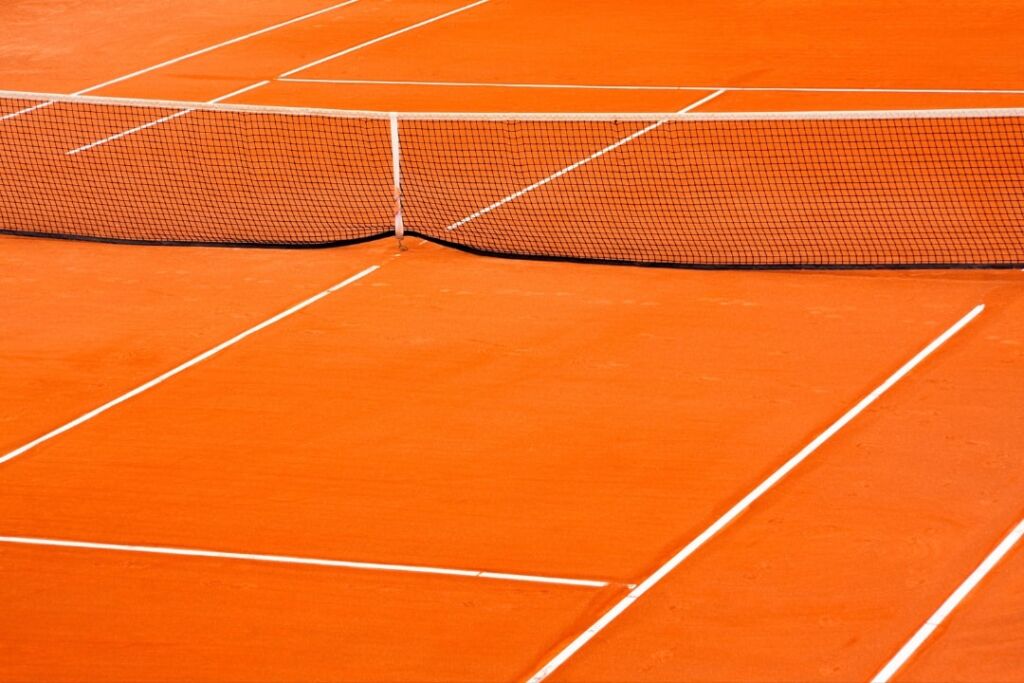
A Hybrid clay court is a fusion of clay and hard court materials. The court concept is still relatively new but is gaining more popularity in the U.S.
Since the court is a hybrid, it will not require as much maintenance as traditional clay courts, but at the same time, it has a similar feel to playing at natural clay courts.
Since the court is relatively new, hybrid clay courts have not been seen in professional tournaments (yet).
8. Artificial Grass Courts
Artificial grass courts are made of synthetic turf, created to mimic the characteristics and playing feel of natural grass courts.
Like traditional grass courts, the ball travels fast and low, but not as much as on natural grass.
They contain plastic glass fibers with better durability than a standard grass court.
This makes synthetic court more resistant to wear over time, as it is unaffected by pests, unlike real grass.
However, the feel cannot fully replicate natural grass. Because of this, synthetic courts are not used in professional tournaments and are only seen on recreational courts.
Recreational courts prefer synthetic courts because they are easier to build and maintain than traditional courts.
9. Artifical Clay Courts
Artifical clay courts are made of synthetic materials designed to mimic the characteristics and feel of natural clay courts.
Unlike natural clay courts, artificial courts do not need regular watering or rolling. It is also easier and faster to install than traditional clay courts.
However, since it is artificially made, the fell will not fully replicate natural clay. Hence, synthetic courts are not used in professional tournaments.
Artificial clay courts are the preferred choice for recreational clubs, as they are easy to build and have low maintenance compared to traditional courts.
10. Carpet Courts
Carpet courts are commonly found indoors as a popular alternative to hard courts. The surface of carpet courts is not as hard as hard courts, so they are generally more forgiving on the knees.
Carpet courts are also considered fast courts where balls travel fast and will also bounce low, but not as much as grass court.
Carpet was used on men’s professional tennis tours, such as the Paris Masters and WTC Finals, for many years but has been discontinued since 2009.
11. Other Types of Tennis Court Surfaces: Wood, Tiles, Canvas
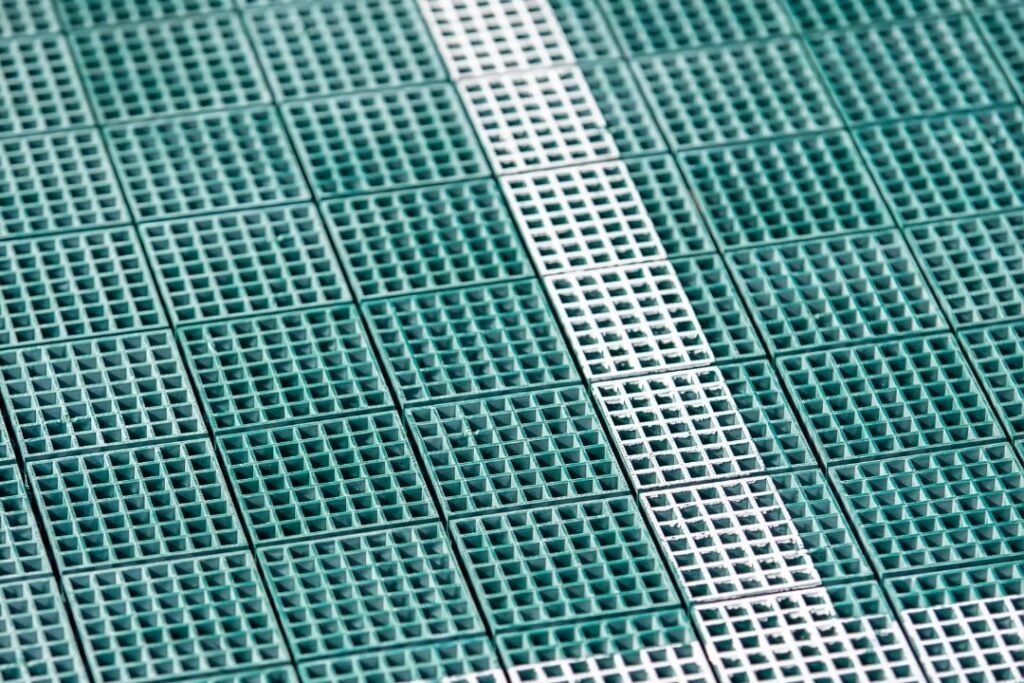
Other courts, such as ones made of wood, tiles, and canvas, are not seen as much in tennis. These courts are not popular but are recognized by the International Tennis Federation (ITF).
Playing tennis on these surfaces is challenging as balls bounce at a high speed and extremely low bounce. These surfaces also tend to be slippery, which makes tennis unplayable.
12. Indoor Courts
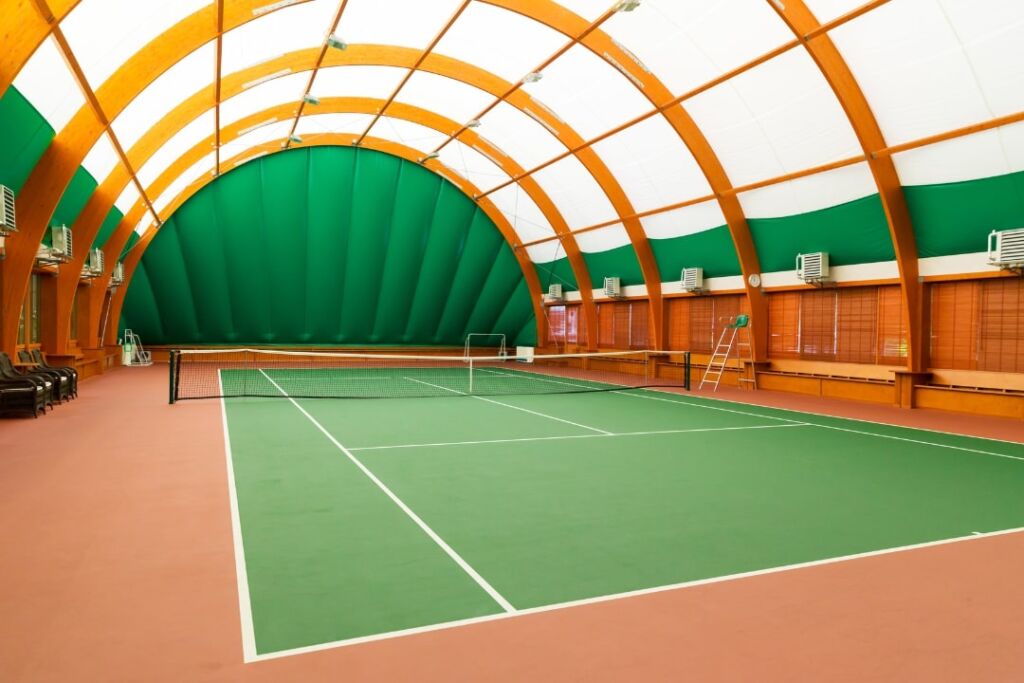
Indoor courts can have any of the surfaces mentioned above. The only difference is having a roof on top, which can slightly change the playing experience.
Since no wind is coming in, the shots are more predictable than outdoors. The speed and bounce of the ball varies depending on the court surfaces used.
Indoor courts have been gaining more popularity in professional scenes. Some ATP tours and challengers tournaments are now being played indoors.
All grand slam main courts now have a retractable roof in case of bad weather.
Wrapping Up
Depending on the court surfaces you are using, it can significantly impact how you play tennis. The strategies differ depending on where you play.
The fast-moving grass court is the opposite of the slow-moving clay court. Even in the professional scene, players who are good at clay courts may be just an average in grass court. The hard court is the more balanced and all-around court.
If you plan to go professional, you must be able to play on all court surfaces. Major tournaments, like grand slams, are played on grass, clay, and hard courts.
Knowing the difference in the court surfaces and the strategies can significantly increase your chance of winning games and your overall tennis level.
Related Questions
What is the Difference Between Clay and Har Tru Tennis Courts?
A standard clay court is red in color, while Har-Tru is a green-colored clay court. Hart-tru tends to be more slippery than red clay courts. Due to the slipperiness, it is also harder to change directions while moving.
Are Clay Courts Better for Knees?
Yes, the materials used for clay courts are softer than other courts. Clay courts tend to be more forgiving to the knees as the ground absorbs more impact on the player’s weight. Players also often slide on clay courts, which reduces the impact of running.
What is the Easiest Surface to Play Tennis On?
A hard court is the easiest surface to play tennis on because it is the most balanced court. Even though clay court is the slowest court, it also requires players to have a lot of stamina and be able to slide around the court to play properly.
What Tennis Court Surfaces Are Used in Grand Slams?
Grass courts are used in Wimbledon tournaments, clay courts are used in French Open and Hard (Acrylic) courts are used in both U.S Open and Australian Open.

